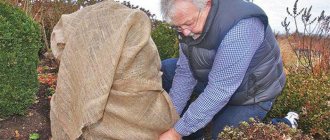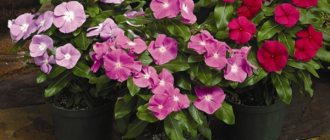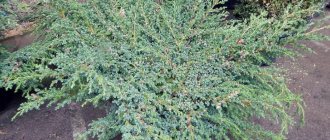Botanical description of the plant
Cypress is an evergreen tree with a pyramidal crown of silver-blue or green color. The bark of the plant is red-brown in color. In their natural habitat, trees can grow up to 30 m; in indoor conditions, its height is usually no more than 2 m.
The leaves of the plant are needle-shaped, often and tightly pressed to the branches. With age, each of them grows to the branch by two-thirds so that only the tip protrudes. Starting from the second year of the cypress’s life, small male and female cones ripen on it. Their diameter is about 1-1.5 cm.
Inexperienced gardeners often mistake cypress for home cypress. They can be distinguished by the color of their needles. The first one is dark green, and the second one is light green. However, caring for these two plants is very similar.
Video: Description and cultivation of cypress
Cypress - a stylish garden decoration
The genus Cypress (Cupréssus) includes about twenty species of plants. These are coniferous trees or shrubs. The crown is pyramidal or spreading.
The leaves are small in size, bluish in color. The needles are located very densely, for the most part fused with the branch: only the upper part of the leaf is free. Because of this, it seems that the branches are covered with scales.
The inconspicuous flowers form small cones, which ripen by the end of the second year.
Cypress habitat
They prefer a mild climate: the Black Sea coast, China, the Himalayas.
Century-old trees reach gigantic sizes, growing up to 35 - 40 m in height.
Representatives of this genus are widely used for decorative purposes. They are an excellent material for green sculptures.
Plants are planted to form hedges and artificial forest belts. Some species can be grown at home.
A little history
Cupréssus is of very ancient origin. The first specimens appeared even before the onset of the Ice Age.
The wood of this amazing tree contains a large amount of resin. Thanks to this, it does not deteriorate for many years. The ancient Egyptians used trunks to build sarcophagi. Researchers have an assumption that it was from this that Noah's Ark was built.
The most common types of cypress
The following types of cypress trees are most often grown as a garden crop.
Evergreen cypress (Cupressus sempervirens)
Adult forms grow up to 30 meters tall, approaching an age of 2000 years. Young trees have a pointed crown, which becomes columnar as it grows, and the crown becomes rounded. Trees with a pyramidal crown are called pyramidal cypress.
Arizona cypress (Cupressus arizonica)
Cupressus arizonica is smaller in size than the previous species, but more frost-resistant. Unpretentious, can grow on dry alkaline soils. The color of the needles is light green. Excellent for forming hedges.
Large-fruited cypress (Cupressus macrocarpa)
This species grows faster than its predecessors and is resistant to sea winds. Therefore, it is used for forest shelterbelts, planted near the banks. The root system is powerful, requiring a greater depth of fertile soil.
Swamp cypress (Taxodium distichum)
Taxodium distichum has another name - taxonium biserialis. This is an amazing plant.
Wild specimens reach colossal sizes: about 36 meters high, and the trunk diameter is 1 – 3 meters. Individual trees were observed whose trunk diameter was 5 meters.
A significant difference from other species is that it is deciduous. Thick, ten-centimeter bark, red-brown in color, furrowed with longitudinal cracks.
Taxonium is two-rowed, prefers moist, marshy places. This species has root outgrowths - pneumatophores, shown in the photo below. They help the tree breathe during flooding. The outgrowths can rise above 1 - 2 meters above the ground and have a cone-shaped shape. It is interesting that pneumatophores are not always formed, but only if there is swampiness.
Cypress propagation
It is quite difficult to purchase quality bushes. Therefore, many gardeners grow seedlings themselves. Cupréssus reproduces well by seeds and also by crown shoots.
Growing from seeds
After collection, the shifts are given a “wintering” - stratification. To do this, they are kept in the refrigerator for several months, then soaked before planting.
Sowing is done in a special soil mixture for conifers. Shoots appear in a month. Since the seedlings grow slowly, for the first 1 - 3 years they are grown at home, like an indoor flower. For the winter, it is advisable to arrange a “wintering”, maintaining a cool air temperature.
Propagation by cuttings
For cuttings, only young branches are taken, separating them from the crown. The shoots are treated with a root formation stimulator, then buried 1/3 into the ground.
The seedlings are covered with a plastic jar or glass. The kind of greenhouse is ventilated daily. It takes about 2 months for rooting.
Preparing the landing site
The plant prefers bright, diffused light, but young specimens must be protected from the scorching rays of the sun. The soil must be drained and well permeable to moisture.
The planting pit is prepared as follows:
- a hole is dug at least 80 cm deep;
- good drainage is required; coarse sand or crushed brick will do;
- the soil mixture is made up of equal parts of turf, humus, sand and peat, or use a mixture of turf soil and pine humus;
- care consists of regular, abundant watering and slight darkening of the seedlings.
The bushes are difficult to tolerate planting, so they are planted together with a lump of earth. If the roots of a dug up seedling are protected by fabric, then it is not removed during planting. The fabric will rot over time.
Planting care
During the first 3–4 years of planting, they are regularly fertilized and watered well. Adult specimens are drought resistant. On hot days, water by sprinkling, otherwise the needles may turn yellow.
How to grow indoor cypress
Homemade cypress in a pot looks very attractive. Green sculptures add a special sophistication to room design.
Houses contain large-fruited cypress; it forms small trees, sometimes reaching two meters in height.
There is another plant that is mistakenly called indoor cypress due to its great external similarity. This is Elwoody cypress. Breeders have developed different varieties for indoor use.
Conifers are quite difficult to grow at home. To do this, a number of conditions must be met.
How to care for cypress indoors
- Lighting is diffused, avoid direct sunlight.
- Special soil for coniferous plants.
- Good drainage is a must.
- Regular watering, without stagnant water.
- Feeding with special fertilizer.
- In winter, it is advisable for the plant to create cooler conditions, about +15 C.
Correct transplant
Plants suffer from root damage quite painfully, so replanting is carried out under certain conditions.
- The procedure is carried out in the spring, after leaving the dormant state.
- The new pot is 3–4 cm larger than the previous one.
- The flower is taken out with a lump of earth, and planted with it in a new container. The top layer of soil is removed. Then all voids are filled with fresh soil.
- Water generously and shade from the sun.
How to grow cypress in your garden
Cupréssus is a decoration for any garden. Pyramid columns give a sophisticated look to the site and provide good protection from the wind. Therefore they are used as wind protection.
However, growing trees in the country is not possible in all climatic zones. They are vulnerable to cold: frost damages the root system and crown, right up to freezing. Even frost-resistant varieties will need to be insulated with the onset of cold weather.
- Planting areas are chosen that are bright, open, and without stagnant water.
- The planting hole is dug to a sufficient depth, approximately 80 cm.
- A drainage layer is placed at the bottom, which is filled with loose soil mixture.
- Seedlings are shaded from the sun and watered regularly.
Diseases and pests
- This plant is most often susceptible to fungal infections. A very dangerous disease is cypress cancer. It is caused by a fungus and is characterized by cracking of the bark. The wounds gradually merge, forming deep cracks from which resin oozes.
- Treatment consists of removing diseased branches. The wounds are then disinfected and treated with a healing composition.
- Aphids can be seen on hedges. It is revealed by the characteristic redness of areas of the crown.
- Drying and yellowing of plants occurs due to the invasion of scale insects.
To combat pest infestations, appropriate chemicals are used.
Crown formation, pruning
Crown pruning is done for several reasons:
- removal of diseased branches;
- maintaining a neat appearance;
- formation of a figured crown;
- trimming hedges.
An educational video will show you how to prune a home tree.
: Pruning cypress at home
Source: https://trudogolikam.ru/flora-i-fauna/kiparis-stilnoe-ukrashenie-sada.html
Obtaining seeds at home
Like all ancient evergreens, cypress has cones with the help of which it reproduces in the wild. Planting material is obtained from ripe cones. In addition, it can be purchased at gardening stores, but this is not at all necessary. Seeds are easily obtained from mature cones, and their germination level is practically no different from store-bought ones.
Features of growing cypress from seeds
Due to the fact that this tree is very heat-loving, it is not particularly popular among breeders in central Russia. After all, it is difficult for a plant to survive a harsh winter and often it simply dies before reaching the warm season. That is why you need to germinate seeds at home, where they will be provided with the optimal temperature. The whole process takes place in several stages:
- Stratification. This complex word means keeping planting material in the cold (in modern conditions it is easiest to use a regular refrigerator). The seeds of many conifers and evergreens must go through such a mandatory “wintering”, otherwise they will not be able to sprout normally. Stratification should last 3-4 months. Soaking. Before planting directly into the ground, the seeds must be kept in warm water for 10-12 hours. This will help them swell.
- Landing. The most suitable option for cypress is the standard arrangement in the ground: 4x4 cm. But you don’t need to use pots for these trees; ordinary wooden boxes will be enough. The main thing is that they have a suitable length and are not too tall, otherwise the seedlings will die.
- Another method of germination is to first place the seeds in sawdust or sand mixture. In such an environment, they must be allowed to sprout their first shoots, and then transplanted into the ground.
- Transfer. The germination rate of cypress seeds is approximately 50%, so it is worth taking a supply of planting material in advance. After the first bushes begin to grow and reach 5 cm in height, they will need to be placed in separate pots. Otherwise, the trees will begin to interfere with each other and will not be able to reach normal size. It is better to keep young animals at home in order to prevent them from freezing. After 10-12 months, if climatic and weather conditions allow, you can take the seedlings out into the yard to stand in the sun.
This is a general scheme for germinating cypress bushes from seeds. However, it requires special care at home. Let's tell you more about it.
Seedling care
As an ornamental plant, cypress is quite capricious. For example, it needs to be sprayed often, but not watered, to avoid rotting. The most vulnerable part of the shrub is the root system.
It takes a long time to form and requires additional strengthening. You can fertilize seedlings with a mixture for coniferous plants about once a month.
Also, during transplantation, there is no need to deepen the roots; they should be closer to the surface, so it is easier for them to absorb nutrients.
Useful tips
As we have already found out, growing cypress from seeds is not an easy task. To implement it, only patience and enthusiasm are not enough; all the rules must be strictly followed.
Let's give a few more recommendations that, according to conifer plant breeders, will help achieve better results.
First, try soaking the seeds before planting not in ordinary water, but in a solution of root or epin.
The roots are the weak point of heat-loving conifers, so such preliminary feeding will not hurt.
Secondly, be careful when choosing the soil. Of course, you can use ordinary soil, but it is better to purchase a special soil mixture. The best option would be a soil composition for coniferous plants, which can be purchased at any specialty store.
The third trick involves using crushed tree bark as natural drainage. It can be poured onto the bottom of the box immediately before planting and covered with soil on top.
Thanks to this, cypress trees will better absorb moisture and will not suffer from its excess.
You can buy bark at the fertilizer department or prepare it yourself (in the latter case, you will need some experience in this matter, so if you are not confident in your abilities, it is better not to risk it).
The last piece of advice concerns transplanting young animals into open ground. This should be done no earlier than a year after the first shoots appear.
Source: https://semena.life/kiparis-iz-semyan-doma.html
How to collect cypress seeds
You can get seeds for planting by purchasing them in a special store. But if possible, it is better to collect planting material yourself.
Important! To check the germination of seeds, several of them can be opened. Dead seed will be empty with some resin, live
-
contain a white or yellow embryo.
The cypress cone season begins closer to autumn.
It is better to collect them from trees growing in a group to get healthier seeds after cross-pollination. Cones can be plucked from the cypress tree or picked up undamaged ones lying on the ground.
After collecting the cones, you do not need to open them yourself; you need to wait for this process to happen on its own - then the seed flies out with a little shaking.
Planting Arizona Cypress
The tree can be grown from seeds or purchased ready-made seedlings. Sprouting from cones is a labor-intensive and time-consuming process, so most owners who want to decorate their plot with cypress trees prefer to purchase sprouts from a special nursery or store.
Planting occurs in several stages.
Preparing for landing
The hole where the tree will be placed must be prepared in advance. Its depth should not exceed 1 m and its width 0.6 m. It is recommended to plant on hills or flat areas, but in no case in lowlands where the crop may die. The distance between individual specimens should be such that the shadow of the seedling does not fall on the neighboring one.
Drainage
To ensure timely drainage of excess liquid from the root system and passage of air, it is necessary to ensure high-quality soil drainage. Broken bricks or tiles are placed at the bottom of the recess, and a mixture of turf, peat, sand and sheet soil is laid on top. All components are taken in equal proportions, only 2 times more soil is added. The embankment should be trampled down a little.
Landing
Young cypress should be planted in the ground with a clod of earth so as not to damage the sensitive roots. The lump and hole with drainage are well watered and the water is allowed to be absorbed. The tree is placed inside, removing the protective cover directly in the hole and carefully straightening the roots.
The neck of the rhizome should not be higher than the surface of the earth, but at the same time it should not be buried too much. The depression is filled with soil, trampled down to avoid the formation of voids, and watered abundantly. After the soil settles, you need to add a little more and water. And when it dries, spread mulch around the trunk. Small plants must be tied to a support until they are completely rooted and strong.
Features of growing plants from seeds
Cypress is a heat-loving plant, for this reason it is necessary to grow it at home from seeds, ensuring optimal temperature and avoiding drafts.
Before planting the material in the soil, be sure to do stratification. To complete this, you need to keep the seeds in the refrigerator for about 3-4 months. This procedure is necessary for the cypress to sprout normally. Before planting in the soil, the seeds need to be soaked in warm water for 10–12 hours to allow them to swell.
How to grow cypress from seeds
Having prepared the seeds, you can move on to the next steps. It is necessary to carry out proper planting and care of seedlings. Next, all stages of cultivation will be discussed in more detail.
Did you know? Cypress wood releases phytoncides that kill moths.
Correct fit
The optimal time for sowing is April - May. To plant seeds, you need to follow these steps step by step:
- Fill the prepared pots with a mixture of soil with leaves, peat mixture, turf and sand in a ratio of 2:1:1:1.
- Place the seedlings on top and cover them with a layer of soil up to 1 cm high.
- Spray the top surface of the soil with a spray bottle.
- Place the containers in a warm place and cover with film.
- Open the greenhouse slightly every 3-4 days.
Seedling care
Sprouts should emerge 2-3 weeks after planting. When this happens, the shelter must be raised and the seedlings sprinkled with a mixture of sand and earth.
It is necessary to provide the sprouts with good ventilation, for which you need to remove the film more often, and after a while get rid of it completely. It is also necessary to maintain optimal soil moisture, avoiding overwatering and dry soil.
Cypress propagation by cuttings
April or the end of June is suitable for this method of propagating cypress at home.
To begin with, select a healthy mother tree. Cuttings must be taken from its upper part, from branches that are no more than three years old. The shoots selected for cuttings are not cut, but rather plucked with a sharp, quick movement. In this case, a piece of bark should remain at the base. The height of the cutting should not exceed 20 centimeters. Cypress propagation by cuttings is the most effective way.
Methods for rooting cypress:
- The needles on the bottom are removed. The branches are kept in a growth stimulator for about a day.
- Planted in boxes prepared in advance. They are filled with sand, which is disinfected with a 3% solution of potassium permanganate.
- The container should have a fairly large number of drainage holes. Place it on a support (legs) so that there is free access of air to the bottom.
- The branches are not deepened too much, only 2-4 cm, covered with film or placed in a greenhouse.
- The optimal temperature for the formation of roots in cypress cuttings is about 20 degrees. At lower rates, film is required. If the air temperature exceeds 20 degrees, then it will be enough to cover the branches with gauze.
- The cuttings are sprayed twice a day. In this case, watering as such is not carried out.
- The cuttings under film, jars or plastic bottles are periodically ventilated.
When the branches form good roots 10 cm long, they can be replanted. It is better to use slightly acidic soil with the addition of peat. After two or three years, the trees are planted in their permanent place.
Indoor or outdoor cypress is a real decoration. With proper planting and care at home, an ornamental tree will delight its owners and purify the air in the apartment, and slender green pyramids of large varieties will help create alleys or hedges near a country house.
Keeping conifers at home - video
Transplanting seedlings
When the sprouts reach a height of 5 cm, they need to be transplanted into separate containers. To perform the transplant correctly, you must follow the instructions:
- Take plastic glasses with a capacity of 0.5 liters for transplanting.
- Make a hole in the bottom.
- Pour a 2-3 cm layer of expanded clay into the glass for drainage.
- Pour soil from soil with leaves, peat mixture, turf and sand into a glass in a ratio of 2:1:1:2.
Growing and caring for the plant
After planting the sprouts, it is necessary to ensure that the cypress is properly grown and cared for. You should also take measures to prevent the plant from being damaged by pests or diseases. Further details about all the subtleties.
Find out also how thuja differs from cypress.
Watering
Despite the fact that indoor cypress is quite moisture-loving, you should be careful when watering. Overwatering is detrimental to the plant, since stagnation of water can cause rotting of the roots.
Excess water from the pan must be removed after watering. Between moistening procedures, the soil should dry out a little. From spring to autumn, the soil can be allowed to be slightly moist. In winter, watering should be reduced. At a room temperature of about +8°C, the tree needs to be moistened every 10 days, around +13°C - after 7.
Wintering
When growing cypress, you need to observe seasonality: it should be warm in the summer, and not hot during the cold season. In winter, the plant should be kept in a cool room, the temperature in which will not exceed +15°C, ideally it should be +8...+10°C.
Important! It is strictly forbidden to place a cypress tree on a windowsill in winter, under which a switched-on radiator is installed. This can be detrimental to the plant.
Cypress can winter on an insulated balcony. If you are afraid of the roots freezing, you need to cover the pot with foam or wrap it in rags.
Top dressing
Domestic cypress needs regular feeding. To do this, it is necessary to use special complex additives for coniferous plants. For example, Activin or Rosafert. In spring and summer it is necessary to apply fertilizer every 2 weeks. There is no need to feed the plant in winter.
Diseases and pests
For cypress, it is important that the water does not sit in the pot, otherwise root rot may appear on the roots. Then the diseased specimen will have to be transplanted into new soil and pot, cutting off the infected roots. But excessive dryness of the soil and air will lead to the appearance of spider mites. If the tree is poorly cared for, then at first it will be visible that it is drying out, and only upon closer examination will the cobwebs be visible, which have entangled not only the foliage, but also the roots.
Another pest is scale insect , which looks like oval plaques on twigs. It sucks out the nutrients from the plant, after which it dries. Aphids are a very popular and active pest, but only if the cypress is outdoors.
to combat all insects is with industrially produced insecticides (Akarin, Arrivo, Antiklesch, Confidor Extra). There is a high probability that one treatment will not be enough. As a preventive measure, spraying with a soapy solution helps .
And to prevent the cypress from drying out, it is important not to forget to constantly moisten the tree and the air around it.
If the leaves still turn yellow, then you can try to find a new place for the plant and feed it.
Pest Control
It happens that pests infest indoor flowers, and this also applies to decorative cypress. Most often it is exposed to the harmful effects of aphids, spider mites and scale insects. As for the first two types of pests, you can get rid of them using special insecticides. The following control method must be used against scale insects: manually remove pests from the flower, and then try to wash all the needles and trunk with a soap or alcohol solution.
Home cypress is an original coniferous plant that will delight its owner and improve the health of indoor air if it is properly cared for. Simple rules - moist air, plenty of sunlight, a porous substrate and timely feeding - will allow you to grow a beautiful indoor flower. The main thing is to follow the rules and not abuse them!
Diseases
Its appearance will help you understand that the plant is sick. The foliage begins to turn yellow, the crown thins, and growths or mold appear on the trunk. The soil may emit a rotten smell, which indicates stagnation of liquid in the pot.
This is what branches that have begun to dry out look like
Yellowness indicates a lack of fluid . Increase the frequency of watering and give the Christmas tree a shower: place the pot in a bathtub without a tray and fill it with warm water. Leave for a couple of hours to let the water drain and return to its original place. The next watering is carried out only after the top layer of soil has dried.
If the crown becomes sparse, check that the pot is not in a ventilated area. Growths on the trunk may indicate a fungus. To eliminate it, treat the flower with fungicides.











